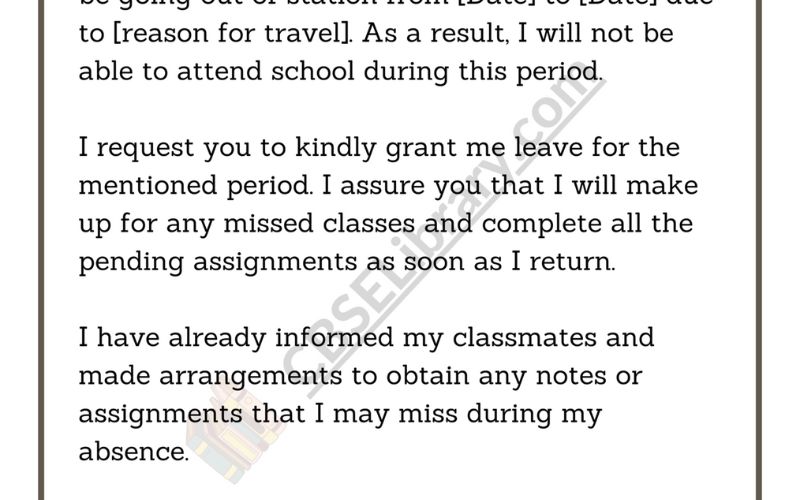As a student, there may be times when you need to take a leave of absence from your studies. Writing an effective student leave letter is crucial, Whether due to personal reasons, medical emergencies, or other extenuating circumstances. This letter serves as a formal request to your academic institution, outlining the reasons for your absence and your plan for returning to your studies.
In this comprehensive guide, we’ll explore the importance of writing a student leave letter, the format and structure to follow, and provide tips to ensure your letter is both professional and persuasive. We’ll also include a sample student leave letter and address common mistakes to avoid, as well as etiquette and frequently asked questions about this important document.
The Importance of Writing a Leave Letter
A student leave letter serves several critical purposes:
- Official Documentation: By submitting a formal written request, you create an official record of your absence, which can be crucial for maintaining your academic standing and ensuring a smooth return to your studies.
- Communication with the Institution: The leave letter allows you to clearly communicate with your school’s administration, explaining the reasons for your absence and your plans for resuming your education.
- Consideration and Understanding: A well-crafted leave letter can demonstrate your professionalism and responsibility, potentially increasing the likelihood of your request being approved and the institution’s understanding of your situation.
- Future Reference: The leave letter may be used as a reference point in the future, should you need to provide documentation or explain the circumstances surrounding your absence.
Format and Structure of a Student Leave Letter
The format and structure of a student leave letter should be clear, concise, and professional. Here is a general outline to follow:
- Header: Include your full name, student ID number, and contact information (address, phone number, email).
- Date: Provide the current date.
- Recipient’s Information: Address the letter to the appropriate person or department, such as the Dean of Students or the Registrar’s Office.
- Subject Line: Clearly state the purpose of your letter, such as “Request for Student Leave of Absence.”
- Introduction: Begin the letter with a brief introduction, stating the reason for your leave request and the specific dates you are requesting.
- Explanation of Circumstances: Provide a detailed explanation of the circumstances that have led to your need for a leave of absence. Be honest and transparent, but avoid excessive personal details.
- Plan for Returning: Outline your plan for returning to your studies, including the anticipated return date and any steps you will take to ensure a smooth transition back to your academic program.
- Conclusion: Close the letter with a respectful and appreciative tone, thanking the recipient for their consideration and understanding.
- Signature: Include your handwritten signature (if submitting a physical copy) and your typed name.
Tips for Writing an Effective Student Leave Letter
To ensure your student leave letter is well-received and successful, consider the following tips:
- Be Timely: Submit your leave letter as soon as possible, allowing the institution ample time to review and process your request.
- Be Specific: Provide clear and detailed information about the reasons for your leave, the dates you are requesting, and your plan for returning.
- Be Professional: Maintain a formal and respectful tone throughout the letter, avoiding overly casual language or emotional appeals.
- Be Proactive: Demonstrate your commitment to your studies by outlining the steps you will take to stay engaged during your leave and ensure a smooth return.
- Be Organized: Ensure your letter is well-structured, with clear section headings and logical flow.
- Be Concise: Keep your letter to the point, avoiding unnecessary details or rambling.
- Be Honest: Be truthful and transparent about the reasons for your leave, as this can help build trust and understanding with the institution.
Sample Student Leave Letter
Here is an example of an effective student leave letter:
[Your Full Name]
[Student ID Number]
[Your Address]
[Your Phone Number]
[Your Email Address]
[Date]
[Recipient's Name]
[Title]
[Department]
[Institution's Address]
Subject: Request for Student Leave of Absence
Dear [Recipient's Name],
I am writing to request a leave of absence from my studies at [Institution Name] for the upcoming [Semester/Quarter] due to a family emergency.
My father has recently been hospitalized with a serious medical condition, and I need to travel home to [City, State] to assist my family during this difficult time. I anticipate being away from campus for approximately [X] weeks, with a planned return to classes on [Date].
During my leave, I will remain in close contact with my professors to ensure I can continue my coursework remotely as much as possible. I have also made arrangements with my academic advisor to develop a plan for catching up on any missed assignments or exams upon my return.
I appreciate your understanding and consideration of my request. Please let me know if you require any additional information from me.
Sincerely,
[Your Signature]
[Your Typed Name]
Common Mistakes to Avoid in a Student Leave Letter
When writing a student leave letter, it’s important to avoid the following common mistakes:
- Lack of Clarity: Ensure your letter clearly states the reason for your leave, the dates you are requesting, and your plan for returning.
- Oversharing Personal Details: While it’s important to provide context, avoid including excessive personal or sensitive information that is not directly relevant to your request.
- Unprofessional Tone: Maintain a formal and respectful tone throughout the letter, avoiding overly casual language or emotional appeals.
- Incomplete Information: Make sure to include all the necessary details, such as your full name, student ID, contact information, and the recipient’s information.
- Poor Organization: Ensure your letter is well-structured, with clear section headings and a logical flow of information.
- Grammatical and Spelling Errors: Carefully proofread your letter to avoid any mistakes that could undermine the professionalism of your request.
How to Address the Recipient of the Leave Letter
When addressing the recipient of your student leave letter, it’s important to use the appropriate title and name. Some common options include:
- Dean of Students: “Dear Dean [Name],”
- Registrar’s Office: “Dear [Registrar’s Name],”
- Academic Advisor: “Dear [Advisor’s Name],”
- Department Chair: “Dear [Chair’s Name],”
If you are unsure of the specific recipient, you can address the letter to the “Office of the Registrar” or the “Office of Student Affairs.”
Leave Letter Etiquette
When it comes to student leave letters, there are a few important etiquette considerations to keep in mind:
- Timeliness: Submit your leave letter as soon as possible, allowing the institution ample time to review and process your request.
- Professionalism: Maintain a formal and respectful tone throughout the letter, avoiding any unprofessional language or behavior.
- Transparency: Be honest and transparent about the reasons for your leave, as this can help build trust and understanding with the institution.
- Responsiveness: Be responsive to any follow-up questions or requests for additional information from the institution.
- Gratitude: Express your appreciation for the institution’s consideration and understanding of your situation.
Frequently Asked Questions About Student Leave Letters
Q: What is the difference between a leave of absence and a withdrawal? A: A leave of absence is a temporary break from your studies, intending to return to your academic program. A withdrawal, on the other hand, is a permanent departure from your studies, often requiring you to reapply for admission if you wish to return.
Q: Do I need to provide documentation to support my leave request? A: Many institutions may require you to provide supporting documentation, such as a doctor’s note or a letter from a counselor, to substantiate the reasons for your leave. Be sure to check with your school’s policies and procedures.
Q: What happens to my academic standing and financial aid during a leave of absence? A: The impact on your academic standing and financial aid can vary depending on your institution’s policies. It’s important to consult with your academic advisor and the financial aid office to understand the implications of your leave.
Q: Can I continue my coursework remotely during my leave of absence? A: Some institutions may allow you to continue your studies remotely during a leave of absence, depending on the reasons for your leave and the specific policies of your academic program. Be sure to discuss this option with your professors and academic advisor.
Q: How long can a student leave of absence last? A: The duration of a student leave of absence can vary, but many institutions have policies that limit the length of a leave to a single semester or academic year. It’s important to check with your school’s specific guidelines.
If you’re a student in need of a leave of absence, don’t hesitate to reach out to your academic institution’s administration. By following the guidelines outlined in this comprehensive guide, you can increase the likelihood of your leave request being approved and ensure a smooth transition back to your studies. Remember, your education is a priority, and taking the necessary steps to address personal or medical concerns is a responsible and proactive decision.





